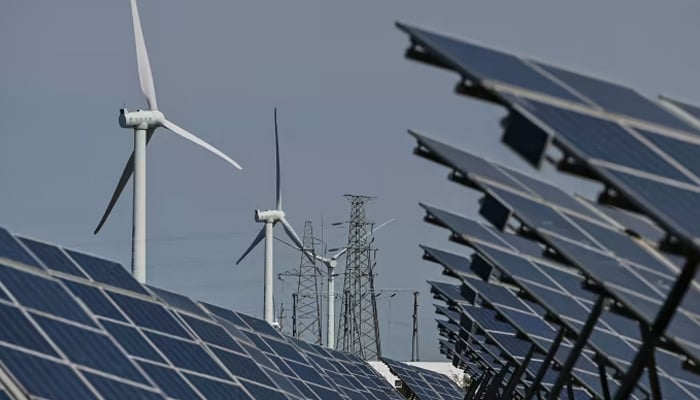Pakistan sets target to double renewable energy share by 2031
SIFC termed it Pakistan’s planned energy transition, targeting to curtail reliance on fossil fuels, transition towards green energy
LAHORE: In a major Special Investment Facilitation Council’s (SIFC) push towards renewable energy, Pakistan has set sights on doubling its share by 2031.
On the energy front, it is aimed at doubling renewables share in the power mix, including hydroelectric, from the present 31 percent to 62 percent by 2031 or in the next eight years.
An SIFC document termed it Pakistan’s planned energy transition, targeting to curtail reliance on fossil fuels and transition towards green energy.
SIFC intends to boost overall power generation capacity from the present 45 GW to 63 GW in 2031. From this expanding generation capacity, SIFC observed a huge renewable energy potential of 3,300 gigawatts in the country, including 2,900 GW of solar and 340 GW of wind, while hydropower potential is estimated at 60 GW. Keeping in view this massive potential, Pakistan’s plan is to expand its RE share in the energy mix to 62 percent from the existing 31 percent. The hydroelectric share is projected to increase from the present 24 percent to 33 percent, solar from the present 02 percent to 19 percent, and wind from the present 04 percent to 10 percent.
Portraying the transformation of the energy mix up to 2031, SIFC projected a 1.5-times increase in overall energy demand — from 90 to 125 million tonnes of equivalent oil — and a 1.7 percent per annum increase in national gas demand — from 4.860 to 5.6 billion cubic feet per day by 2030, scaling up installed power capacity to 51 gigawatts by 2025 due to growing needs, increasing oil demand by 2.4 percent per annum, an estimated gas demand-supply gap of 4 billion cubic feet per day (BCFD) by 2030, an expansion in the electricity transmission network by 20,000 km lines, and generation and transmission gaps of 15.2 gigawatts due to system limitations.
Titled “The Land of Immense Potential and Opportunities,” the document outlines investment opportunities in the country in the four sectors: agriculture and livestock, information technology, mines and minerals, and energy. Referring to prospective energy needs, it underscores the expansion of power generation and transmission capacities and the import of additional gas.
Besides, Pakistan is ideally located to connect energy-rich Central Asian Republics (CARs) with the world. Plentiful opportunities are available to invest in renewable energy projects (hydel, solar, and wind) and strategic oil and gas refinement and transmission systems, it adds.
It mentioned various key facts about the energy sector. As much as 53 percent of refined petroleum oil is imported, which stood at $12.1 billion in 2022. Pakistan has been blessed with coal reserves of 186 billion tonnes, which is 50 billion tonnes of oil equivalent. The generation and transmission gaps stand at 15.2 gigawatts due to system limitations.
The document outlined the following investment opportunities: solar PV projects in Punjab (600 to 1,200 MW), Diamer-Bhasha Dam Hydro Power Project (4,500 MW), transmission line projects in Punjab and Sindh (500 KV), reactive power compensation devices (2,000 MVAR), battery storage for frequency regulation (1,000 MWh), power projects at Thar Coal Block II, Sindh (1,320 MW), hydropower projects at Rajdhani (132 MW), Aramco Oil Refinery, and Turkmenistan, Afghanistan, Pakistan, and India’s (TAPI) gas pipeline.
-
 Princess Beatrice, Eugenie Resort To Begging Sarah Ferguson: 'It'll Bring Disaster For The Whole Family'
Princess Beatrice, Eugenie Resort To Begging Sarah Ferguson: 'It'll Bring Disaster For The Whole Family' -
 Jenny Slate Hails Blake Lively Amid Lawsuit Against Justin Baldoni
Jenny Slate Hails Blake Lively Amid Lawsuit Against Justin Baldoni -
 Sophie Wessex Shares 'frustration' From Early Days In Royal Family
Sophie Wessex Shares 'frustration' From Early Days In Royal Family -
 Jason Momoa's Aquaman Unseen Snap Revealed
Jason Momoa's Aquaman Unseen Snap Revealed -
 Prince Harry Taught Only Way King Charles 'will Take Him Seriously'
Prince Harry Taught Only Way King Charles 'will Take Him Seriously' -
 Meghan Markle’s Reaction To UK Talks With Prince Harry Comes To The Forefront: ‘Leaving Me?’
Meghan Markle’s Reaction To UK Talks With Prince Harry Comes To The Forefront: ‘Leaving Me?’ -
 Taylor Swift Slams Justin Baldoni In Explosive Text Messages, Court Filing Reveals
Taylor Swift Slams Justin Baldoni In Explosive Text Messages, Court Filing Reveals -
 Blake Lively’s Drops New Allegations Against Justin Boldoni About Birth Scene
Blake Lively’s Drops New Allegations Against Justin Boldoni About Birth Scene -
 Andrew's Reasons For Giving Sarah Ferguson A Rent-free Home For 30 Years After Divorce Finally Finds An Answer
Andrew's Reasons For Giving Sarah Ferguson A Rent-free Home For 30 Years After Divorce Finally Finds An Answer -
 Charlie Puth Reveals Wake-up Moment That Made Him Quit Alcohol
Charlie Puth Reveals Wake-up Moment That Made Him Quit Alcohol -
 Meghan Trainor Welcomes Baby Girl Mikey Moon Trainor And Turns Emotional
Meghan Trainor Welcomes Baby Girl Mikey Moon Trainor And Turns Emotional -
 Meghan Markle Would Not 'hide Away' From UK For Harry's Sake
Meghan Markle Would Not 'hide Away' From UK For Harry's Sake -
 Why Keith Urban's Daughters Are Avoiding His Rumored Girlfriend? Source
Why Keith Urban's Daughters Are Avoiding His Rumored Girlfriend? Source -
 Sarah Ferguson Led Andrew To Jeffrey Epstein: ‘She Wanted Him To Ask For More Money’
Sarah Ferguson Led Andrew To Jeffrey Epstein: ‘She Wanted Him To Ask For More Money’ -
 Blake Lively Claimed Justin Baldoni 'made A Monster' Of Her, Court Docs Reveal
Blake Lively Claimed Justin Baldoni 'made A Monster' Of Her, Court Docs Reveal -
 Prince William Accused Of 'harsh Decisions' Over Disgraced Royal
Prince William Accused Of 'harsh Decisions' Over Disgraced Royal




